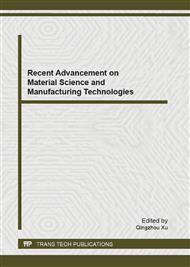p.177
p.184
p.190
p.194
p.199
p.206
p.210
p.215
p.219
Structure-Property Relationship of Dodecylbenzenesulfonic Acid Doped Polyaniline
Abstract:
Dodecylbenzenesulfonic acid (DBSA) doped polypanilines (PANIs) were chemically synthesized in different molar ratios of aniline (An) to ammonium persulfate (APS) and An to DBSA. The microstructures of these PANIs were investigated by means of scanning electron microscope (SEM), X-ray diffraction (XRD), and Fourier Transform Infrared (FTIR). UV-Vis spectrometer, semiconductor parameter analyzer, ubbelohde viscometer and electrospinning technique were used to characterize the optical, electrical properties, viscosity and solubility of these PANIs. The results show that the molar rations of An to APS and An to DBSA had strong effect on the microstructure, molecular weight, degree of crystallinity, optical property, solubility and conductivity of obtained DBSA doped PANI. With the increase of the molar ratios of An to APS and An to DBSA, the conductivities and molecular weight of DBSA doped PANIs decreased, while the degree of crystallinity and solubility of DBSA doped PANIs increased. The DBSA doped PANI could dissolve in dichloromethane or HFIP and could be fabricated short fibers by electrospinning. Moreover, the solution of DBSA doped PANIs in concentrated sulphuric acid showed liquid crystal property.
Info:
Periodical:
Pages:
199-205
Citation:
Online since:
July 2013
Authors:
Keywords:
Price:
Сopyright:
© 2013 Trans Tech Publications Ltd. All Rights Reserved
Share:
Citation:


